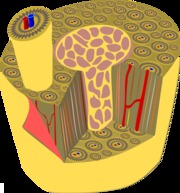Also called gonadal deficiency, hypogonadism (hypo = under) means that the sex glands produce little or no hormones. In men the glands are the testes that produce androgens, and in women the ovaries that produce estrogens.
There are many possible reasons for this condition, and the cause can be primary or central. Primary means that the problem is located in the gland itself, while central means that the problem is to be found elsewhere, in this case in the brain. Hypogonadism is a sign and may point to a disease, but hypogonadism by itself is not considered a disease.
Primary hypogonadism causes include:
In central hypogonadism the hypothalamus and pituitary gland do not function properly. Causes can include:
In girls if hypogonadism occurs during childhood, they will not begin menstruation, and the body height will be affected as well as the appearance of sexual characteristics such as breast growth and body hair. If it occurs after puberty, symptoms include:
In boys before puberty it affects sexual characteristics such as beard growth, muscle growth and height. After puberty the symptoms include:
If a brain tumor is the cause symptoms can be:
Quick weight loss such as in anorexia nervosa and gastric bypass surgery may also cause central hypogonadism.
Doctors use blood tests to diagnose hypogonadism. Checks include:
Treatment is almost always hormone replacement therapy. Many forms of Hypogonadism are treatable and patients have good prognoses.
Turner syndrome is a genetic condition in which cells are missing one or part of one sex chromosome, it occurs in 1 out of 2000 live births.
The aims of the treatment are a) to ensure a proper height with growth hormone, because without it the patient stays very short, and b )to ensure the sexual characteristics with estrogen replacement therapy.
The patient can have a normal life if monitored carefully by an experienced doctor.
Alternative name for Klinefelter syndrome is 47 XXY syndrome. Klinefelter syndrome is one of a group of sex chromosome problems, and results in males who have one or more extra X chromosomes, for example XXY instead of XY. It occurs in 1 out of 500 – 1000 newborn boys.
Usually it is diagnosed when a man comes to a doctor because of infertility
The following test may be performed:
Testosterone therapy can be used, to improve the growth of body hair, muscles, increase energy, and sex drive, self esteem, concentration and strength.
Most men with this syndrome are not able to reproduce; however an infertility specialist may be able to help.
This is a rare genetic condition, characterized by hypogonadism, eunuchoidism, and anosmia. It results from the failure of the hypothalamus which results in hormonal imbalance.
Kallman Syndrome is treated with hormone replacement therapy.
Hyperprolactinemia is a condition in which too much Prolactin is present in the blood of women who are not pregnant and in men. In women it results in a decline in the body’s production of progesterone which in turn can lead to irregular ovulation and menstruation.
SARMs for the treatment of osteoporosis and hypogonadism.
Selective Estrogen Receptor Modulators (SERMs) are medicines intended to produce some of the effects of the natural hormone estrogen. Not too long ago women were routinely given estrogen supplements after menopause in hopes that the replacement hormone would prevent some of the ravages of aging, including bone loss. The popularity of hormone replacement therapy among doctors has declined as doctors have come to feel the downsides outweigh to benefits. The drug category SERMs - one reason for the interest in them is that they promise the bone-building benefits of replacement estrogen without the downsides.
For a time it was fashionable to give post menopausal women estrogen. Called Hormone Replacement Therapy (HRT) this was a preventative therapy prescribed by doctors to millions of women. These were oral supplements of a form on estrogens. Estrogen acts through two receptors called ERa and ERb. Osteoblasts express ERb, but it isn’t clear that ERb agoinsts promote bone density.(Estrogen is also a class of compounds. These drugs are derived from plants.)

